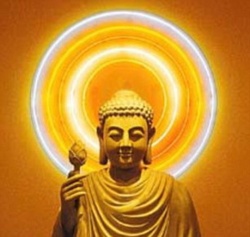Difference between revisions of "A refuge"
(Created page with "thumb|250px| <poem> A refuge (saraṇa) is a place one goes to in order to find peace, security and safety. The Buddhist considers continual rebirth in saṃ...") |
|||
| Line 1: | Line 1: | ||
[[File:Halo.jpg|thumb|250px|]] | [[File:Halo.jpg|thumb|250px|]] | ||
| + | |||
| + | |||
| + | |||
| + | |||
<poem> | <poem> | ||
| − | A refuge (saraṇa) is a place one goes to in order to find peace, security and safety. The Buddhist considers continual rebirth in saṃsāra to be an unenviable prospect and believes the Buddha, the Dhamma and the Saṅgha to be a refuge from this. Thus the Buddha, Dhamma and Saṅgha are often called the Three Refuges. The Buddha is a refuge in that his enlightenment demonstrates that saṃsāra can be transcended, the Dhamma is a refuge in that it shows how enlightenment can be attained and the Saṅgha is a refuge in that it offers the guidance, encouragement, example and support needed to transcend saṃsāra. When a person decides to become a Buddhist, they recite a simple formula in which they affirm their confidence in and commitment to the Three Refuges. This formula is :– | + | A [[refuge]] ([[saraṇa]]) is a place one goes to in order to find [[peace]], {{Wiki|security}} and safety. |
| + | |||
| + | The [[Buddhist]] considers continual [[rebirth]] in [[saṃsāra]] to be an unenviable prospect and believes the [[Buddha]], the [[Dhamma]] and the [[Saṅgha]] to be a [[refuge]] from this. | ||
| + | |||
| + | Thus the [[Buddha]], [[Dhamma]] and [[Saṅgha]] are often called the [[Three Refuges]]. | ||
| + | |||
| + | The [[Buddha]] is a [[refuge]] in that his [[enlightenment]] demonstrates that [[saṃsāra]] can be transcended, the [[Dhamma]] is a [[refuge]] in that it shows how [[enlightenment]] can be [[attained]] and the [[Saṅgha]] is a [[refuge]] in that it offers the guidance, encouragement, example and support needed to transcend [[saṃsāra]]. | ||
| + | |||
| + | When a [[person]] decides to become a [[Buddhist]], they recite a simple [[formula]] in which they affirm their [[confidence]] in and commitment to the [[Three Refuges]]. This [[formula]] is :– | ||
Buddhaṃ saraṇaṃ gacchāmi | Buddhaṃ saraṇaṃ gacchāmi | ||
| Line 7: | Line 19: | ||
Saṅghaṃ saraṇaṃ gacchāmi | Saṅghaṃ saraṇaṃ gacchāmi | ||
| − | This means: ‘I go to the Buddha for Refuge. I go to the Dhamma for Refuge. I go to the Saṅgha for Refuge.’ The formula is usually repeated three times. What the upanayana, sacred thread ceremony, is to Hindus, baptism is to Christians and reciting the shahada is to Muslims, going for refuge is to Buddhists. | + | This means: ‘I go to the [[Buddha]] for [[Refuge]]. I go to the [[Dhamma]] for [[Refuge]]. I go to the [[Saṅgha]] for [[Refuge]].’ |
| + | |||
| + | The [[formula]] is usually repeated three times. What the [[upanayana]], [[sacred]] thread {{Wiki|ceremony}}, is to [[Hindus]], baptism is to [[Christians]] and reciting the shahada is to {{Wiki|Muslims}}, [[going for refuge]] is to [[Buddhists]]. | ||
| − | See also: Refuge | + | See also: [[Refuge]] |
| − | The Three Refuges, Nyanaponika, 1983. | + | The [[Three Refuges]], [[Nyanaponika]], 1983. |
</poem> | </poem> | ||
{{R}} | {{R}} | ||
Latest revision as of 05:03, 8 January 2016
A refuge (saraṇa) is a place one goes to in order to find peace, security and safety.
The Buddhist considers continual rebirth in saṃsāra to be an unenviable prospect and believes the Buddha, the Dhamma and the Saṅgha to be a refuge from this.
Thus the Buddha, Dhamma and Saṅgha are often called the Three Refuges.
The Buddha is a refuge in that his enlightenment demonstrates that saṃsāra can be transcended, the Dhamma is a refuge in that it shows how enlightenment can be attained and the Saṅgha is a refuge in that it offers the guidance, encouragement, example and support needed to transcend saṃsāra.
When a person decides to become a Buddhist, they recite a simple formula in which they affirm their confidence in and commitment to the Three Refuges. This formula is :–
Buddhaṃ saraṇaṃ gacchāmi
Dhammaṃ saraṇaṃ gacchāmi
Saṅghaṃ saraṇaṃ gacchāmi
This means: ‘I go to the Buddha for Refuge. I go to the Dhamma for Refuge. I go to the Saṅgha for Refuge.’
The formula is usually repeated three times. What the upanayana, sacred thread ceremony, is to Hindus, baptism is to Christians and reciting the shahada is to Muslims, going for refuge is to Buddhists.
See also: Refuge
The Three Refuges, Nyanaponika, 1983.
